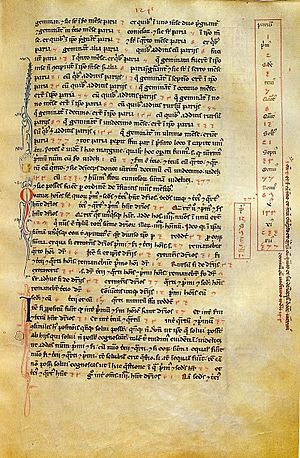Liber Abaci facts for kids

The Liber Abaci (which means "The Book of Calculation" in Latin) was a very important math book written in 1202. It was created by Leonardo of Pisa, who is better known today as Fibonacci. This book became famous for helping to bring Arabic numerals (the numbers we use every day, like 1, 2, 3) to Europe.
Contents
Why This Book Was Important
The Liber Abaci was one of the first books in the Western world to explain the Hindu–Arabic numeral system. This is the number system we use now, with digits from 0 to 9. It also showed how to use symbols that look like our modern "Arabic numerals".
Fibonacci wrote this book for both business people and mathematicians. He wanted to show everyone how much better the new number system was. He also showed how useful these new numbers could be for everyday calculations.
Some people think the book's title means "The Book of the Abacus." However, the word "abacus" at that time meant "calculation" in general. Fibonacci's book actually taught people how to do math without an abacus. For a long time, there was a debate between those who used the new "Indian method" (called algorismists) and those who stuck to the old abacus and Roman numerals (called abacists).
What's Inside the Book
The Liber Abaci is divided into several parts, each covering different math topics.
Learning the New Numbers
The first part of the book teaches the Hindu–Arabic numeral system. It shows how to switch between different ways of writing numbers. This section also includes the first known way to check if a number can be divided by other numbers (called a composite number). It also explains how to find its factors.
Math for Business
The second part gives many examples for business. It shows how to change between different types of currency (money) and measurements. It also teaches how to calculate profit and interest on money.
Fun Math Problems
The third part explores many interesting math problems. For example, it talks about the Chinese remainder theorem, which helps solve puzzles about remainders. It also mentions perfect numbers and Mersenne primes. Fibonacci also included ways to solve problems with number patterns and square pyramidal numbers.
One famous problem in this section is about how fast a population of rabbits grows. The solution to this problem creates a special number pattern. Even though the problem existed before Fibonacci, this is why the Fibonacci sequence is named after him today!
Estimating Numbers
The fourth part of the book shows how to estimate numbers that are not whole numbers. These are called irrational numbers, like square roots. It explains how to find close answers using both numbers and shapes.
Fibonacci's book also includes proofs from Euclidean geometry. His way of solving algebraic equations was influenced by an Egyptian mathematician named Abū Kāmil Shujāʿ ibn Aslam.
Fibonacci's Way of Writing Fractions
When you read Liber Abaci, you might notice that Fibonacci wrote fractions differently. His way was somewhere between the Egyptian fractions (which used only fractions with 1 as the top number, like 1/2 or 1/3) and the common fractions we use today (like 2/3 or 3/4).
Here are a few ways his fractions were different:
- Placement: Today, we write a fraction to the right of a whole number, like 2 and 1/3. Fibonacci would often write the fraction to the left, like 1/3 then 2.
- Combined Fractions: He sometimes wrote several numbers above and below a single fraction bar. This was a way to show a sum of fractions. For example, he might write something that meant 4/5 + 2/(3x5) + 1/(2x3x5). This was handy for dealing with old systems of weights and measures.
- Adding Fractions: Fibonacci also wrote several fractions next to each other to show they were added together. For instance, 1/4 next to 1/3 next to 2 would mean 2 + 1/3 + 1/4.
Because his notation was complex, Fibonacci showed many ways to change fractions from one style to another. He even included a method for turning a regular fraction into an Egyptian fraction. This method is now known as the Fibonacci–Sylvester expansion.
The "Indian Method"
In Liber Abaci, Fibonacci proudly introduced the "Modus Indorum," which means "the method of the Indians." This is what we now call the Hindu–Arabic numeral system or base-10 numbers. He also showed the digits that look very much like our modern Arabic numerals.
Fibonacci wrote that his father, who worked in a customs house, introduced him to mathematics. He was amazed by the "nine Indian figures" (9, 8, 7, 6, 5, 4, 3, 2, 1). He learned from people in Egypt, Syria, Greece, and other places. He felt that the "Indian method" was much better than other ways of calculating.
He explained that with these nine figures and the sign 0 (which Arabs called "zephir"), any number could be written. Before this, Europe mostly used Roman numerals, which made complex math very hard. So, Fibonacci's book was very important for spreading decimal numbers. However, it took many centuries for the Hindu-Arabic system to be fully adopted across Europe. It really sped up in the 1500s when printing became common.
History of the Book
The first version of Liber Abaci came out in 1202. We don't have any copies of that exact version today. A newer, updated version was released in 1227 CE. Many copies of parts of this book still exist. There are at least three complete copies from the 1200s and 1300s.
For a long time, there were no printed versions of Liber Abaci. The first Italian translation was printed in 1857. The first full English translation was published in 2002.

